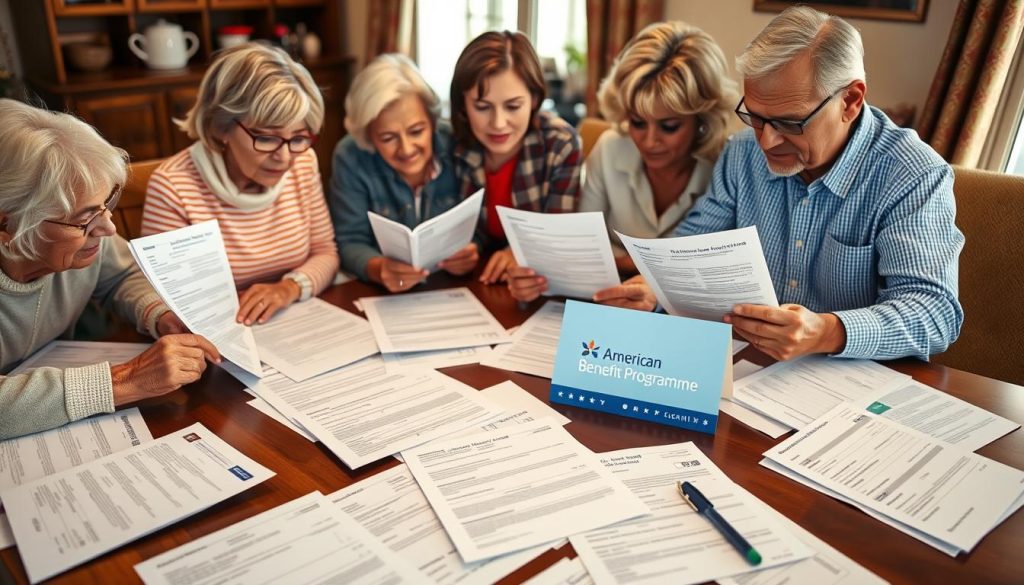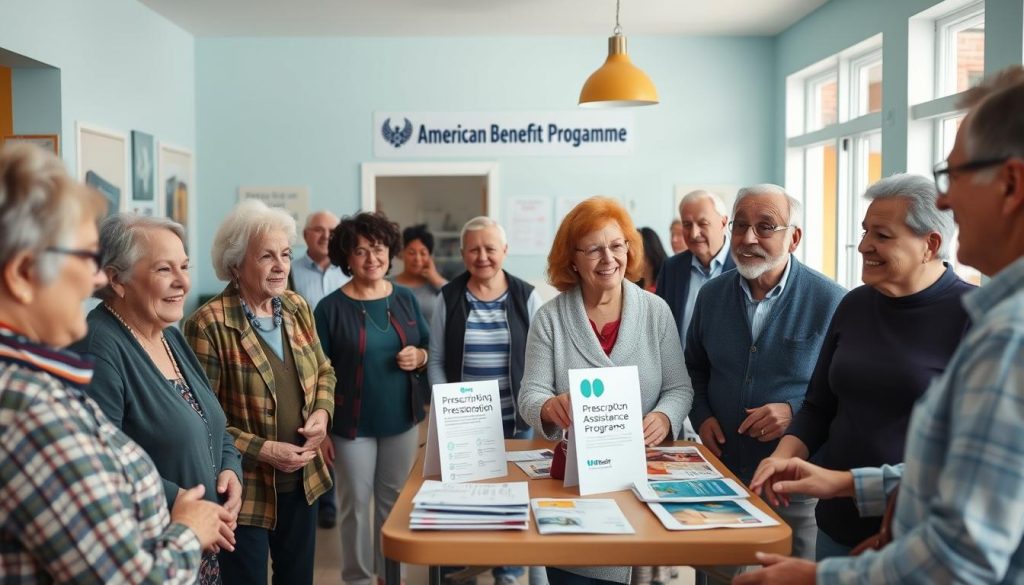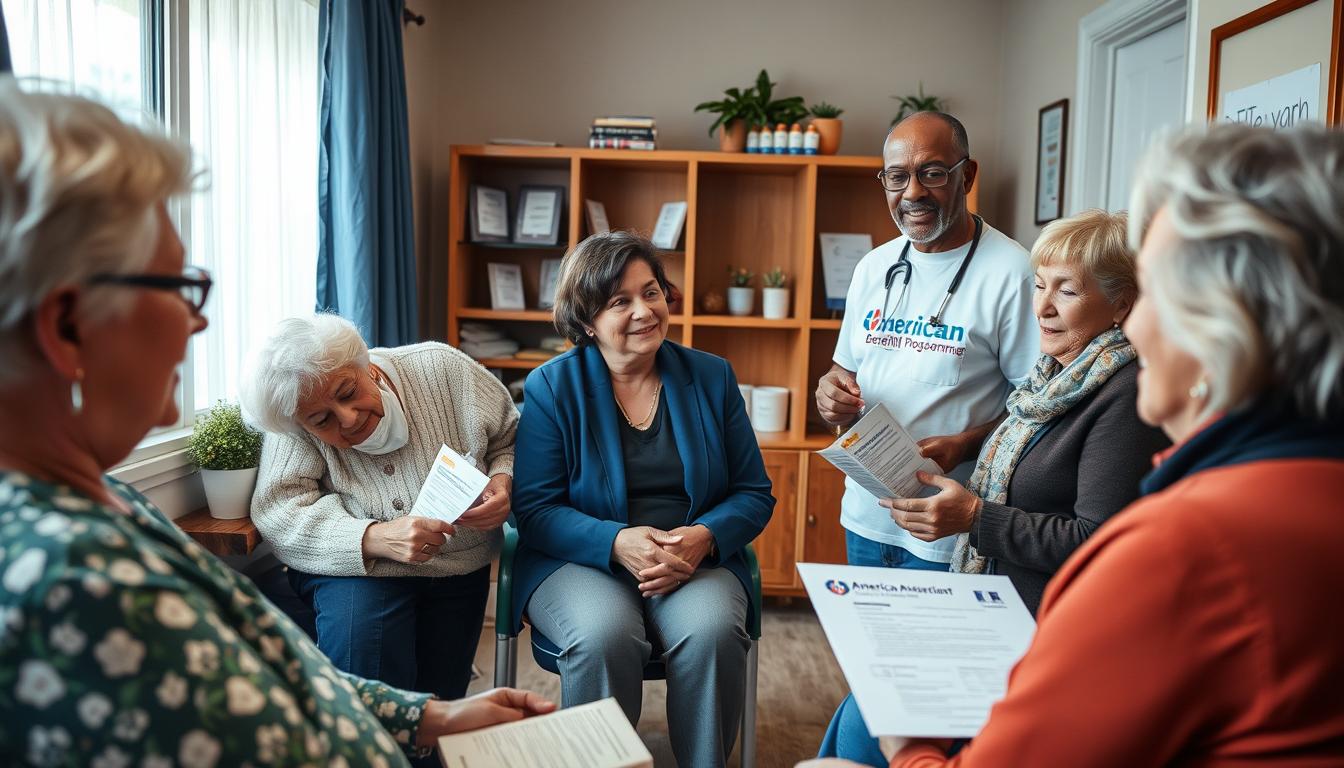Have you ever thought about how many people don’t take needed medicines because they’re too expensive? Health care costs keep going up. So, programs that help with drug costs are very important. They give financial help to those who struggle to pay for their meds. Many folks, without insurance or not enough insurance, find it hard to get the treatments they need. Luckily, lots of groups are there to help. These include drug companies and nonprofits.
For example, AstraZeneca has a plan to make inhaler costs only $35 for some people1. The Genentech Patient Foundation gives out free meds. There are many helpful programs out there for people who need them. So, it’s important to know about these programs. This way, you can find the best help for you.
Key Takeaways
- Prescription drug assistance programs are crucial for individuals facing high medication costs.
- AstraZeneca and Boehringer Ingelheim are capping inhaler prices at $35 starting in June 2024.
- Genentech and other organizations provide free medications to those lacking insurance.
- Discount clubs and pharmacy savings programs can significantly reduce out-of-pocket costs.
- Resources like NeedyMeds can offer further assistance and information.
- Many programs target specific patient demographics, making access tailored to individual needs.
Understanding Prescription Drug Assistance Programs
Prescription drug assistance programs (PAPs) help many who struggle to buy their medicines. They offer medicines for free or at a low cost. These programs are run by drug companies, state governments, and nonprofit groups.
Between 2011 and 2013, patients got an average of 4.2 PAP orders each year. But from 2014 to 2016, this number went down to 3.1 orders per patient. This happened at a rate of 3.0% each month2. Even with fewer orders, the money saved per order went up from $870.40 to $1,086.40 after the Affordable Care Act (ACA)2. This meant over $3,000 in yearly savings on medicines for patients using PAPs after ACA2.
Factors like income and resources affect who can get into these programs. The Extra Help program gives about $5,900 a year to those who qualify. Singles need resources under $17,220 and couples under $34,360 to be eligible3. Sometimes, even if you earn more, you might still qualify because of your family size or where you live3.
Some assets, like your main house and personal things, don’t count towards these limits3. Knowing how these programs work, including how to apply, is key to getting help with medicine costs.
Who Can Benefit from Medication Help Programs
Medication help programs are important for people who find it hard to buy prescriptions. They mainly help those without insurance and those not fully covered by insurance. These programs provide needed support.
Individuals Without Insurance
Uninsured people often have trouble affording their medicines. They make up a large group that needs help. The Genentech Patient Foundation gives free medicine to those who qualify financially. This makes important treatments reachable.
AstraZeneca is also helping by setting inhaler prices to $35 for those without insurance starting June 1, 20241.
Underinsured Individuals
Underinsured people have insurance but still face high costs. Programs like DUPIXENT MyWay® and MerckHelps™ ease this burden. They help people get the medicines they need without heavy costs.
Boehringer Ingelheim will also cap inhaler costs at $35 for the underinsured, starting June 1, 20241. The Healthwell Foundation offers financial help too. It supports underinsured people through Disease Funds, making medical expenses more manageable4.
Types of Prescription Drug Assistance Programs
Many people need help to pay for their medication. There are different programs designed for them. These programs make it easier for people to get the medicines they need.
Pharmaceutical Company Assistance Programs
Some people don’t have insurance. Pharmaceutical aid programs help by offering cheap or free medicines. People need to show how much they earn to get help. Most drug companies have programs to help those who can’t afford their medications5. A lot of the time, people can save a lot by choosing generic drugs5.
State Drug Assistance Programs
State drug programs help folks who can’t afford their meds. They mainly help older people and those with disabilities. These programs work with Medicare to cover extra costs. The Extra Help Program is one example. It helps people with Medicare with their medicine costs if they don’t earn much6. There are also programs for people with HIV/AIDS who don’t have much money or insurance6.
Nonprofit Organizations and Charities
Nonprofits and charities also offer help with medicine costs. The PAN Foundation is one place that gives money for meds6. Websites like FundFinder show people over 200 financial aid programs. This makes finding help easier6.
| Type of Program | Description | Eligibility Requirements |
|---|---|---|
| Pharmaceutical Company Assistance Programs | Provide low-cost or free medications to qualified individuals | Income eligibility criteria apply; must lack insurance |
| State Drug Assistance Programs | Aid for low-income seniors and disabled adults with medication costs | Must meet income and resource limitations; state residency required |
| Nonprofit Organizations | Financial support and medications through charitable foundations | Varies; generally based on income and need |
How to Find Prescription Drug Assistance Programs
Looking for help with prescription drugs can feel hard, but there’s hope. Many places online and in the community can help. They make it easier to find ways to save on medicine.
Online Resources and Databases
Using sites like the PAN Foundation’s FundFinder helps a lot. This tool gives info on over 200 programs that help with medicine costs6. It makes finding the right help faster and simpler.
Community Health Centers
Local health centers are great for getting medication help. They have staff ready to help you apply and find what you need. They can connect you to programs that aren’t well-known.
Pharmacists as Resources
Pharmacists know a lot about saving on medicine. They know about discounts and savings right where you live. Talking to them can help you find ways to spend less on your medicine.
Eligibility Criteria for Rx Assistance Services
It’s important to know who can get help with medications. To get this help, you need to meet some rules. These include how much money you make, where you live, and your insurance. Most programs look for similar things, like your income and certain papers.
Income Requirements
How much money you make is key for drug help programs. For instance, to get help from Pfizer, your family’s income before taxes must be within 300% of what’s called the Federal Poverty Level. This rule helps decide if you can get help paying for medicines or get them for free7. There are over 375 programs in the U.S. wanting to help people who don’t have much money8.
Residency and Insurance Status
Where you live matters when asking for help. Also, whether you have insurance or not affects if you can get help. The Pfizer program lets people with Medicare or Medicaid apply7. If you fit into the income rules of the Extra Help program, things look good. You might not have to pay some costs and only pay a little for your medicines4.
To apply, you’ll need to show some papers like how much you earn and where you live. Reading about what each program needs can help. You can find more info here.
| Eligibility Criteria | Description |
|---|---|
| Income Limits | Must be at or below 300% of Federal Poverty Level for many programs. |
| Residency Requirement | Applicants must be residents of the state where assistance is sought. |
| Insurance Status | Uninsured or underinsured individuals generally qualify more readily. | Documentation | Proof of income such as W2 forms, pay stubs, or tax returns. |
Last, knowing the money rules and other needs for getting medication help is a clear way to help people in need784.
Applying for Pharmaceutical Aid Programs
To apply for pharmaceutical aid programs, begin by gathering necessary documentation. This documentation is very important. It helps make sure the application process goes well. It often includes things like proof of how much you make, if you have insurance, and a valid ID. Getting these documents ready ahead of time makes it easier to get help with medicine costs.
Gathering Necessary Documentation
What you need for medication help can vary by program. Usually, you need:
- Proof of income, like pay slips or tax forms
- Insurance ID or policy details
- A government-issued ID
- Medical records or prescriptions for the medicines you need
Having these documents ready helps make applying for aid quicker and avoids delays.
Understanding Application Processes
Each aid program has its own way of applying. It’s important to know these requirements well. Some programs let you apply online, while others need papers mailed in. Knowing how to apply helps you get help faster. It’s good to stay up-to-date on how to apply for aid programs. This makes the whole process smoother.

Nowadays, more groups are helping people who need it. Programs like the Genentech Patient Foundation and MerckHelps™ offer lots of help. They guide you through applying and what documents you need9. By getting your documents ready and knowing how to apply, you can better your chances of getting aid1.
Steps to Access Drug Cost Support
Finding help for high drug prices is very important. The first step is to see if you qualify. Check things like how much money you make and if you have insurance. For example, a single person can make up to $22,590 to get Extra Help in 2024. A married couple can make up to $30,6604. Knowing these numbers helps a lot.
Then, look for programs that fit your needs. The PAN Foundation has info on help with copays and who can get it. This can make finding help easier.
Next, gather all the papers you need. Fill out the forms carefully. Once you send in your application, make sure to follow up. This helps make sure your application gets looked at fast. Keeping in touch with the people running the program helps too. This is key because people with Extra Help will not pay for premiums or deductibles in 202510.
Navigating Medication Affordability Assistance
Finding help to afford medication can be tough. But, patient advocates are here to help. They support people who struggle with medication costs. Patient advocates explain options and help with applications.
They also tackle problems that come up. This makes getting needed medication easier.
Using Patient Advocates
Patient advocates are a big help when you know little about assistance programs. They know a lot about available help and can check if you qualify. Advocates work with drug companies and doctors to get medications cheaper.
Collaborating with Healthcare Providers
Working with healthcare providers helps too. Doctors know about different programs and can suggest ones that fit. They help fill out the paperwork needed for these programs. By teaming up, patients have an easier time dealing with medication costs.
“The key to overcoming financial barriers in healthcare is collaboration and advocacy.”
Getting help from patient advocates and doctors makes a big difference. Over 41.2 million Americans need help with medication costs. Their knowledge is vital for accessing necessary treatments11. Working together also uncovers many drug programs online, helping patients more efficiently12.
Effective Strategies for Medication Savings Programs
Finding ways to cut down on prescription costs is important for many. Strategies for medication savings programs can help a lot. Getting discount cards and coupons is a good first step. They make meds cheaper at some stores.
Utilizing Discount Cards and Coupons
There are lots of programs to save money on meds. Sites like GoodRx let people compare prices and get coupons. This can help save a lot13. Sites like NeedyMeds and RxAssist also offer help and info on saving on meds.
Joining Pharmacy Savings Clubs
Joining savings clubs at pharmacies is another great idea. These clubs offer special discounts. They are especially good for saving on generic meds14. This is great for people who need many meds for long-term health issues.
| Strategy | Description | Potential Savings |
|---|---|---|
| Discount Cards | Cards that provide discounts at participating pharmacies. | Up to 80% on certain medications. |
| Coupons | Manufacturer coupons that reduce copays for brand-name drugs. | Can save hundreds yearly for brand-name medications. |
| Pharmacy Savings Clubs | Membership programs offering lower prices on medications. | Significant savings on generics and some brand-name drugs. |
Using these strategies for medication savings programs makes dealing with prescription costs easier. For more info, visit this resource. It has lots of ways to help with med costs.
Local Resources for Prescription Medication Assistance
Getting affordable medicines can make life better for many people. Local help for medication lets people find the assistance they need. Several community medication programs and plans made for each state help people get the prescriptions they need.
Community Programs and Initiatives
Many community programs help those who can’t pay for their medicines. Programs like the Community Assistance Program and the NeedyMeds Drug Discount Program are open to everyone. They help people get their medicines without worrying about how much money they make or fitting into tight rules15. Local groups also work hard to make meds cheaper by working with drug stores and medicine makers.
State-Specific Resources
State health departments create special ways to help people get medicines. They have programs for people with low income or no insurance. This way, these people can get treatment for long-term health issues like Diabetes and Hypertension without spending too much16. Some states also have pharmacy discount cards. These cards let people buy medicines at a much lower price. This saves money for both grown-ups and kids16. These efforts show how much states are dedicated to keeping their residents healthy and well.

| Program/Resource | Description | Eligibility Criteria | Contact Info |
|---|---|---|---|
| Community Assistance Program | Offers medication assistance without income limits. | No financial criteria | N/A |
| NeedyMeds Drug Discount Program | Provides resources to lower prescription costs. | No requirements | N/A |
| Partnership for Prescription Assistance | Helps individuals find assistance programs. | Uninsured or underinsured | N/A |
| Mobile Free Pharmacy Program | Delivers free over-the-counter medications to low-income individuals. | Low-income adults and children | N/A |
| AstraZeneca Patient Assistance | Capped inhaler prices at $35. | Commercially insured or uninsured | N/A |
Using these local resources for medication assistance helps people get important medicines. Knowing about these community medication programs can close the gap between needing help and getting it15.
Common Barriers to Accessing Prescription Drug Assistance Programs
Getting help from prescription drug programs can be hard due to several barriers. For example, the process to apply is often complex. This makes it tough for people to get the medication help they need. The amount of paperwork needed can be too much for many. So, this can stop even those who really need help from applying.
Complex Application Processes
The struggle often starts with complicated application steps. Studies show that patients face many challenges on their way to getting medication. This includes knowing they need help and getting a prescription sorted17. Every step can be hard, with things like understanding health terms and slow systems making it harder17. The lack of clear instructions makes it tough for many to finish their applications.
Limited Awareness of Programs
Not knowing about available help also stops people from getting the assistance they need. Many, especially those with low incomes, don’t know about options like health centers18. For example, one out of three people in poverty rely on these centers for care. But, many don’t know these resources exist18. Not knowing about help available makes it harder for people to get the care they need. This is worse in locations without enough pharmacies or healthcare places19. We must understand and tackle these barriers to help everyone get the medication they need.
Conclusion
Medicine help programs are very important for people without insurance. They make it easier to get the medicine people need. A lot of doctors, about 97.6%, use these programs to help their patients20.
Also, 89% of doctors say it’s hard to use these programs. They say the process is long and tough. This shows why it’s important to know about these programs20. Knowing helps patients get the help they need.
In closing, using these drug help programs is key. Working with doctors and using resources can save money. It can also help people stick to their medicine plans. This can make a big difference in health21.
Source Links
- Drug Assistance Programs
- Use of Prescription Assistance Programs After the Affordable Health Care Act
- Understanding the Extra Help With Your Medicare Prescription Drug Plan
- Help with drug costs
- 7 Programs to Help Pay for Medications
- How to find financial assistance for your prescription medications – PAN Foundation
- For Patients | Pfizer RxPathways
- Patient Assistance Programs and Types of Assistance – AssistRx
- Merck Patient Assistance Programs to Help Those in Need
- Getting Help Paying for Prescriptions
- How to Help Your Low-Income Patients Get Prescription Drugs
- Affordability
- 7 easy ways to help pay less for your prescriptions
- 6 Ways to Reduce Prescription Drug Costs
- Prescriptions – NC 211
- Prescription Assistance Program
- The patient’s medication access journey: a conceptual framework focused beyond adherence
- Barriers Associated with Access to Prescription Medications in Patients Diagnosed with Type 2 Diabetes Mellitus Treated at Federally Qualified Health Centers
- Let Your Pharmacist Be Your Guide: Navigating Barriers to Pharmaceutical Access
- Pharmaceuticals Companies’ Medication Assistance Programs: Potentially Useful but Too Burdensome to Use?
- Experts Offer Clashing Views of Patient Assistance Programs, Kickbacks, and the Court

Leave a Reply